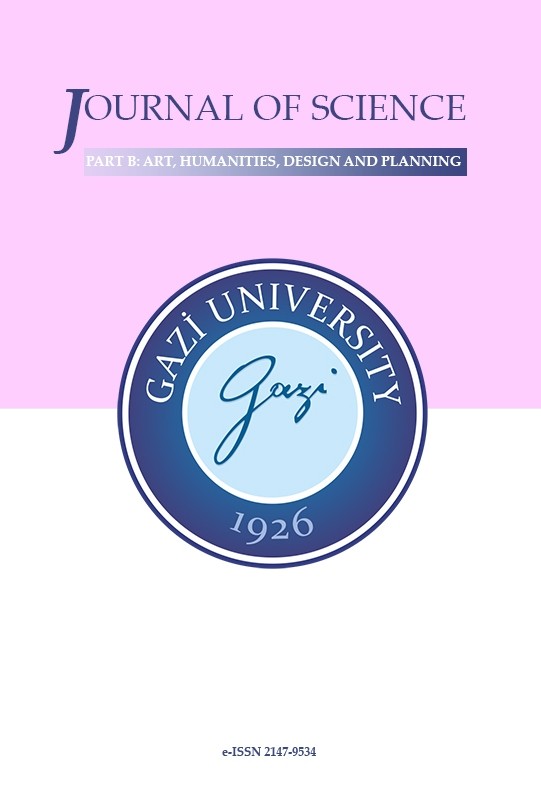Evaluation of the Accessibility of the Disabled in Urban Areas on the Sample of the National Library
Evaluation of the Accessibility of the Disabled in Urban Areas on the Sample of the National Library
Architectural Design, Accessibility, Accessible Library Barrier-free City, Physical Disability,
___
- [1] Keskin, N. (2011). Engellilere yönelik İzmir ili Bornova örneğinde kentsel yeşil alan standartlarının belirlenmesi, Master Thesis, Ege University, İzmir.
- [2] Aktaş, M. D., Güngör, C., & Sahil, S. (2023). Special Educational Buildings and Accessibility. Gazi University Journal of Science Part B: Art Humanities Design and Planning, 11(2), 253-268.
- [3] Sirel B., Boyacıgil O., Duymuş H., Konaklı N., Altunkasa F. & Uslu C. (2012). Çukurova yerleşkesi açık alanlarının fiziksel engelliler bakımından ulaşılabilirliğinin değerlendirilmesi, Çukurova Üniversitesi Mühendislik Mimarlık Fakültesi Dergisi, 27(1), 53-72.
- [4] URL-1. TSE 12576. (https://intweb.tse.org.tr/) Last Accessed: 02.07.2023
- [5] Ürker, Ş. (2010). Türk Mevzuatında Özürlülük Terminolojisi. Özveri Dergisi, 7(1): 48-55.
- [6] Upias. (1976). Fundamental Principles Of Disability. London.
- [7] WHO. (2011). World report on disability, WHO Publications, Geneva.
- [8] Lee, T. M. (2005). Multicultural citizenship: The case of the disabled. D. Pothier, ve R. Devlin (Ed.), Critical Theory: Essays in Philosophy, Politics, Policy and Law, UBC Press, Vancouver.
- [9] Hahn, H. (1986). Disability and the urban environment: A perspective on Los Angeles. Environment and Planning D Society and Space, (4), 273-288.
- [10] Çağlar, S. (2009). Uluslararası Hukuk ve Türk Hukuk Sisteminde Engellilerin Eğitim Hakkı ve Devlet Yükümlülükleri, Beta Yayınları, İstanbul.
- [11] Akatlı, G., & Güngör, C. (2016). Evaluation Of Selected Public Libraries And Their Surrounding Environments In Ankara With Regard To Turkish Standards Related With Accessibility. Gazı Unıversıty Journal Of Scıence Part B: Art, Humanıtıes, Desıgn And Plannıng, 4(4), 67-81.
- [12] URL-2. United Nations (UN). (2008) Convention on the rights of persons with disabilities. (http://www.un.org/disabilities/documents/convention/convoptprot-e.pdf) Last Accessed: 02.07.2023
- [13] Mishchenko E.D. (2014). Herkes İçin / İle Tasarım: Evrensel Tasarıma Katılımcı Bir Yaklaşım Deneyimi, Mimarist, (50), 105–111.
- [14] Yılmaz, M. (2012). Kapsayıcı Tasarım ve Mekân, Mimarist, (43), 107 – 111.
- [15] Duranton, G., Guerra, E. (2016). Developing a common narrative on urban accessibility: An urban planning perspective, Brookings, Washington DC.
- [16] Kuntay, O. (2006). Erişilebilirlik. Planlama, (1) 75.
- [17] Çakın, İ. (2011). Bilgi ve Belge Yönetimine Giriş, Hacettepe Üniversitesi, Ankara.
- [18] International Federation of Library Associations and Instutions (IFLA) (2005) Libraries for the blind in the information age guidelines for development, International Federation of Library Associations and Institutions. IFLA Professional Reports, Nr. 86. The Hague, IFLA Headquarters.
- [19] URL-3. The National Library. (http://www.mkutup.gov.tr/) Last Accessed: 02.07.2023 [20] Kesik, O. A., Demirci, A., & Karaburun, A. (2012). Analysis of Pavements for Disabled Pedestrians in Metropolitan Cities. Lap Lambert Academic Publishing.
- Yayın Aralığı: Yılda 4 Sayı
- Başlangıç: 2013
- Yayıncı: Gazi Üniversitesi
Urban Morphology Schools: A Review of the English, Italian, and French Schools of Thought
Esra BAYIR, Mustafa Adil KASAPSEÇKİN
Urban Preference of Higher Education Migrants in the Context of Network and Social Capital
EN-SUITE BATHROOM ANALYSIS IN A TRADITIONAL TURKISH HOUSE: YALVAÇ HOUSE AND GUSÜLHANE
Nuriye Hande KUTBAY, Cemil YAVUZ
Typological analysis of wooden minaret mosques in Tokat.
Elif YAPRAK BAŞARAN, Özlem SAĞIROĞLU DEMİRCİ
Considering Industrial Design In The Context Of Communication: The Concept of Design Communication
Evaluation of the Accessibility of the Disabled in Urban Areas on the Sample of the National Library
Lost Tangible Cultural Heritage: A Traditional Tokat House Restoration Project
Ayorinde OLUYEMİ, Oluwafemi ADELABU, Professor E.b. Oladumiye OLADUMİYE
